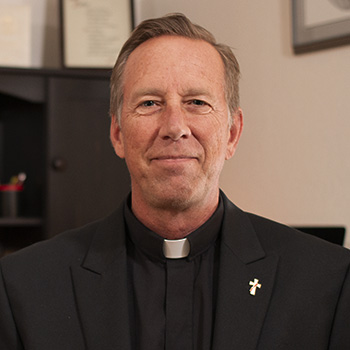Mary Magdalene demonstrates that an intimate relationship of communion with Christ is a lived and transformative experience.
By Deacon Frederick Bartels
22 July 2017
Today is the feast of St. Mary Magdalene, whose life with Jesus of Nazareth teaches us many important elements of Christian discipleship. One that stands out above all others is the way in which her life was totally transformed by an intimate relationship of communion with Jesus Christ. For Mary, this led to a unique, wondrous horizon which opened up before her. Although we know almost nothing of Mary’s life prior to meeting her Savior and Redeemer, it is certain that what was before an ordinary existence soon became extraordinary as the light of God permeated her heart. For Mary, the incarnate Son of God became the object and goal of her life; Jesus came to take first place in her thoughts, as is evident by her urgent journey to the tomb on that third day after his terrifying and scandalous crucifixion.
Although people often think Mary was a prostitute, there is no explicit biblical or historical evidence to back such a claim. Perhaps this mistake is due to Luke’s first mention of Mary following the story of the sinful woman who wet Christ’s feet with her tears, wiped them with her hair, and anointed them with ointment (ch. 7). However, Luke does not mention the sinful woman’s name. There is no reason to assume this woman was Mary Magdalene. Additionally, there seems to be no mention from any of the Church Fathers, whose writings helped to hand on and develop the apostolic tradition of the Church, about Mary having any sort of dishonorable or immoral reputation.
Luke does tell us that Mary was called “Mag’dalene, from whom seven demons had gone out” (8:2). Seven is a mysterious biblical number which suggests “completeness” and thus signifies that Mary’s demonic affliction was particularly severe. However, demonic possession or obsession, whatever the case may be, of itself does not constitute moral culpability, nor definitively indicate a life of grave sin.
Jesus Christ, seeing into her heart with his infinitely compassionate gaze, mercifully drives the demons from her and bestows upon her his gift of divine healing (see Mk 16:9). From that point on, Mary’s allegiance to Christ appears to be constant, unwavering and filled with zeal. Not even the scandal of the cross turned her away, as it did the other disciples save John. Given its terrifying nature, she remained there, with the Mother of Jesus and the beloved disciple John, to the very end (Jn 19:25).
The gospel for today is the resurrection story found in John (20:1-2, 11-18). Here we learn that Mary went to the tomb early in the morning on the day of Christ’s resurrection. Her Lord, whom had healed her of demonic infestation and introduced her to the reality of a new kind of life, whom she had devoutly followed and to whom she had lovingly ministered for so many days, opening her life to him and fixing upon him her every thought, had been brutally executed as a common criminal on a Roman cross. Nevertheless, she remains steadfast in her ardent love for Christ: she is grief-stricken by the events of the last few days and perhaps suffering from anxiety. It is difficult to see how she would have thought anything but that all was lost. Her world, hopes, and dreams had been dashed by the death of her Lord.
But as the sky begins to lighten, she notices something perplexing and disturbing: the heavy stone sealing Jesus inside the tomb had been removed. Mary runs to Simon Peter and the disciple John and tells them, “They have taken the Lord from the tomb, and we don’t know where they put him.” The gospel then picks up again with Mary standing outside the tomb, weeping. She had returned, as desire would dictate, to the last place she had seen her Lord, once again to the most recent, close point of contact with him.
One of the beautiful things about God is that he finds an ardent desire for him to be irresistible. The more God is craved, the more our gaze is fixed on him in humility and love, the more he draws us to himself and showers upon us his divine treasures. Interestingly, desire for God is of itself only possible following the prevenient gift of grace. It is always the divine Other, whose love is creative, restorative and sanctifying, who first mysteriously whispers to the human heart, instilling there a thirst for himself. He calls, we respond, moving us from the ordinary to the extraordinary; from a life of loss to a life of fulfillment; from disfigurement to restoration, healing and glory by granting us a share in his own divine life.
The gospel account of Mary’s discipleship teaches us that same truth. Christ first healed her, she then followed him. Yet that is only the beginning of her story. Her relationship with Christ deepened, developed, and then culminated in her lived experience of the resurrection event in a surprising, unexpected and mysterious encounter with her Lord, whom she calls “Rabbouni.”
And as she wept, she bent over into the tomb and saw two angels in white sitting there, one at the head and one at the feet where the Body of Jesus had been. And they said to her, “Woman, why are you weeping?” She said to them, “They have taken my Lord, and I don’t know where they laid him.” When she had said this, she turned around and saw Jesus there, but did not know it was Jesus. Jesus said to her, “Woman, why are you weeping? Whom are you looking for?” She thought it was the gardener and said to him, “Sir, if you carried him away, tell me where you laid him, and I will take him.” Jesus said to her, “Mary!” She turned and said to him in Hebrew, “Rabbouni,” which means Teacher. Jesus said to her, “Stop holding on to me, for I have not yet ascended to the Father. But go to my brothers and tell them, ‘I am going to my Father and your Father, to my God and your God.'” Mary Magdalene went and announced to the disciples, “I have seen the Lord,” and then reported what he told her. (Jn 20:11-18)
It is not difficult to imagine Mary’s excitement, astonishment and overwhelming joy over once again seeing the Lord. The crucifixion, in all its stark brutality, agony and horror, had not defeated him. Death and the darkness of the sealed tomb had no power to bind him. Contrary to the physical nature of things, he who was once crucified, dead and buried is now alive and risen! A new, sublime light flowed into her world, life and heart: the singularly unique power of the risen Jesus. After her encounter with Christ at the tomb, things were never the same for Mary. In virtue of her intimate relationship with the risen Son of God, she could never again return to old ways, nor be bound by the chains of sin which enslave us all. Through her love, a doorway had opened into eternity and everlasting communion with God. Christ had truly freed her, not simply from her natural fears, but from the greatest threats to human life: sin, evil and unending death.
So whoever is in Christ is a new creation: the old things have passed away; behold, new things have come.
2 Cor 5:17
The life of Mary Magdalene should serve as a paradigm for us all. We too are in need of healing, for some type of “demons” infest each of us, perhaps not literally (although that may be for some), but they are nonetheless in some way real and quite dangerous. It is Christ who, in virtue of his sacred Paschal Mystery, freely bestows a most necessary, merciful and transformative healing to all who approach him in faith. In duplication of Mary’s self-entrustment to the Savior, we too can experience fulfillment in the life of intimate and personal communion with him. This life begins with faith, baptism, and our grace enabled self-gift to Christ, leads to discipleship, and from there finds its fullness in not only a participation in his saving mission but a sharing in the very divine life which he possesses.
This life is identical with the Catholic life of holiness, lived out sacramentally in full communion with the body of Christ, the Church. It is indeed a wondrous, transformative and re-created existence, upon which the darkness of the tomb gives way to a new and sublime horizon: here the brilliant light of the resurrected Christ, through the sending of his Spirit into your heart, has not merely remade who you are, but has restored your likeness to Christ through a grace and Spirit-filled process. It’s a new life not simply worth living for; it’s worth dying for.
Christ’s peace.
Photo Credit: Guido Reni [Public domain], via Wikimedia Commons.

Deacon Frederick Bartels is a member of the Catholic clergy who serves the Church in the diocese of Pueblo. He holds an MA in Theology and Educational Ministry, and is a Catholic educator, public speaker, and evangelist who strives to infuse culture with the saving principles of the gospel. For more, visit YouTube, iTunes and Twitter.


Leave a Reply